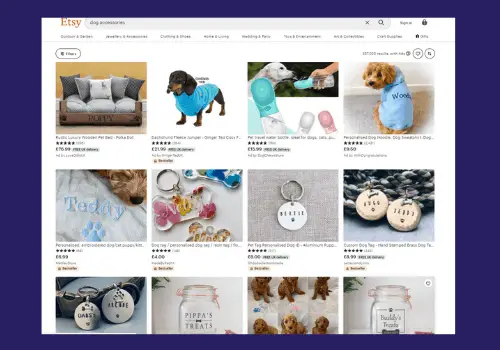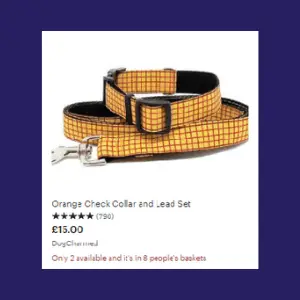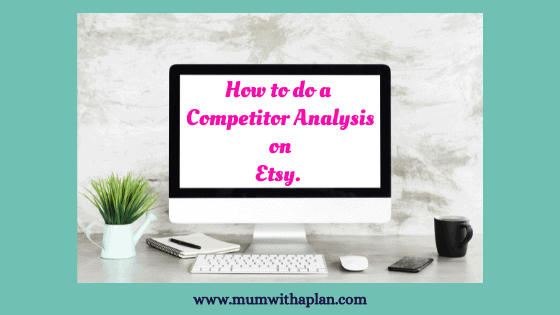Last Updated on 6th August 2021 by Allison
Analysing your competitors is a crucial process for any business, and should be included as part of your market research when starting a new business.
It helps you to understand who your competitors are, what they are doing, and how they are performing in the marketplace.
If you have not yet done your Etsy Competitor Analysis, then this post is for you!
We will go through the steps of analysing your Etsy competitors so you can take advantage of their successes and hopefully learn from any errors they may be making.
What is Market Research?
Market Research is a broad term and can mean many different things.
The most common definition of Market Research is to analyse a market, competitive environment or potential product for business reasons.
Market research allows small businesses to better understand their customers so that they are able to create more relevant products and marketing strategies in order to increase sales. It can also help businesses to decide on which markets to focus on and which products to launch.
This research is vital for any company that wants to grow their business, because without it they would have no idea how well or not so well a product will fare in the market.
As an Etsy seller, you need to know who your competitors are, and what type of products they are selling. Understanding this will allow you to focus your efforts on the aspects of your business that matter most and help grow it more effectively
It is so important that every seller on Etsy does their research before opening their store.
This is the best way to analyse what your Etsy competitors are selling, and how busy they are.
What is Competitor Analysis?
This is a very important part of your market research strategy.
It is basically looking at the way your direct competitors operate, what they sell, and how well they do it. You always want to be thinking of ways to be better than them.
By this, I don’t mean selling your items at a lower price.
It could be clearer descriptions in your listings, taking better photos, having a more cohesive looking Etsy shop front or selling a wider variety of items.
Knowing who your Etsy competitors are can be a good way to gauge how you can potentially perform in the market.
To put it simply, if you find that there are many similar products on offer but yours is not selling as well then perhaps you need to rethink how you are presenting it to potential customers.
Understanding what type of products they sell and their SEO strategy can also be very revealing
Why is it so Important?
Knowledge is Power!
By conducting in-depth market research, and analysing your direct competition on Etsy, it will be easier for you to plan what to sell, and how to hopefully get seen in the marketplace. It helps to see what is already working, and what is popular amongst customers.
RELATED POSTS: HOW TO OPEN AN ETSY SHOP.
How do I find my Competitors on Etsy?
It is easier to find your competitors if you know exactly what you will be selling on Etsy.
I will walk you through how I would conduct research for my dog accessories Etsy account as an example.
Please be aware that you should be looking at your competitor’s accounts at least once a year, even if you performing well. If nothing else, it will keep you on your toes!
I try and look at my fellow Etsy sellers twice a year. I save the data I collect to compare it the next time.
Finding My Etsy Competitors.
I start by typing ‘dog accessories’ into the search bar to see what comes up.

Ignoring the top row of results, which are always adverts, none of the next 3 rows are relevant as they are for things like treat jars or dog tags.
I go back to the search bar and narrow it down a bit by typing in ‘dog collar and lead’.
Again, I ignore the adverts.
Looking at the top 3 rows (12 listings in total), there are 5 results from the same seller. Now, I know they don’t make their own products, which is really annoying, as it’s a breach of Etsy’s policies, but I just need to get over that and move on…
I move on by ignoring them, as well as the next listing, who also doesn’t make their own products.
I am looking for products, similar to the style of collar and lead that I make, from a seller that is performing well. The easiest way to figure that out is by looking at their feedback score.
Here is an image of mine in a search result so you know what to look for.

As you can see, under my item description are 5 black stars and 798 in brackets.
This means that I have received 798 Etsy feedback reviews and 5 stars.
Roughly speaking, the feedback number is usually between 5-15% of the Etsy seller’s total sales. My total sales are 5,873, which is 13.5% (A high feedback percentage is a good sign of a popular shop). I just use 10% to make it easier to work out.
I carry on looking at the results until I find 5 shops selling similar items to me, that have a feedback score of at least 700.
What Should be Included in an Etsy Competitor Analysis?
It is important to have a clear understanding of what you should be looking for on Etsy.
How long have they been on Etsy?
This is found at the bottom, where it says the ‘about me’ blurb. If they haven’t filled it in, then it won’t come up.
Number of Sales.
You can find that at on their shop page, underneath the banner.
If you go to their shop and look on the left hand side, it will say how many sales and how many admirers they have. Sometimes, you can click on the items sold and it will show you what they have been selling. Many of the busier sellers (myself included) have disabled this option. It is handy though, when someone hasn’t worked out how to turn it off!
Are Their Sales Recent?
Some Etsy sellers may have really high sales figures, but their shops are 10 years old and they hardly make any sales now.
I like to make a note of the total sales from the sellers I am looking at, then go back in 3 days time to track what their sales are again.
You can also look at the dates of their customer feedback for a good sign.
Customer Feedback.
As well as looking at dates, I look at what their customers are saying. Are they known for quick delivery, are the items well made?
Are there any negative comments?
Amount of Products on Sale.
Do they have many products listed? Are they in different categories so that it is easy for a customer to navigate and find different things?
Their Item Titles.
Are they using more than one description for each item? Are they SEO optimised by using different descriptions of their item?
Their Item Descriptions and Photos.
Are their Item descriptions informative and easy to read? Are their photos clear?
Is their Shop Well Organised?
Have they posted an Etsy update recently or is it months old? Do they have a good store banner which looks professional, and do they have store policies in place?
The successful sellers usually have organised and up to date Etsy shops. Customers can see that this is a professional business and they are wanting to make a good impression to any customers.
Is Their About Me Section Filled Out?
I get suspicious when people don’t fill in their About Me section on Etsy. I’m not saying they have to have a complete life story in there, but it’s a good way of a potential buyer seeing the sort of personality you are.
The 2 Etsy sellers I spoke about earlier, who I know don’t make their own products, don’t have any About Me sections, or a photo of themselves. They both just have a first name, and that’s it.
People who spend a lot of time handmaking things to sell, usually want people to know who they are and why they do what they do.
Do They Have a Social Media Presence?

I just go to my Instagram account and search for the shops to see if they are on there, and if they are, do they post regularly? Do they use Etsy related hashtags in their posts?
I also like to look at their profile and see if they link to their Etsy site or if they have a separate website or blog as well. If they do, I like to visit their site and see if it is similar to their Etsy site.
Having a social media presence indicates they have a marketing plan in place, even if it is only a basic one.
Have a Look on Google.
Google can be a good place to see any other reviews or find what other social media platforms they use.
Other Ways to Check out the Competition.
There are a few external tools you can use to help you with your Etsy Competitor Analysis.
Marketplace Pulse.
This is a website that shows a report of the top 100 sellers of various online marketplaces, with Etsy being one of them.
It shows the name of the Etsy shop, category they sell in, location and the amount of sales they have had over the last 30 days (most of which are mind-boggling!).
It’s good to have a look at if any of the top sellers sell in the same category as you, so you can see an example of what can actually be achieved!
Is it Free?
This is a free tool you can utilise.
Go to www.marketplacepulse.com and have a look for yourself.
Erank.
This website can help you identify keywords that buyers are using on Etsy, have a look at what your competitors are doing, monitor how your shop is doing compared to others, any emerging trends and quite a bit more.
Is it Free?
There is a free plan, but it is quite limited for what you can do. I use their basic plan which costs $5.99. I have only been using it for a few months and I know I’m not using it to it’s full potential yet. I need to add it to my list of things to look at properly if I ever get a moment…
It would be worth paying for Erank for just a month to be able to see the best sellers in your category and in your country as well. You can also see things like how many sales they have per day which is one of the things I always like to have an idea of.
Go to www.erank.com and have a look around their blog and features page etc.
What Can this Analysis Tell you About your Competition?
The most important thing you can determine, by looking at other sellers, is if there is a demand for your type of products.
It’s pointless opening up if no one is going to be interested. If there are many other Etsy shops selling similar things to you, it looks like there is definitely a demand already there.
It may seem daunting seeing lots of other people on Etsy selling products similar to yours, but, if you have faith in your products, then just go for it!
Use the research you have done, to make sure you are competing with what the best of the rest have to offer.
You can also have a look at Etsy’s Handbook as there are articles there you may find helpful.
In Summary.
As I said earlier, carrying out an Etsy Competitor Analysis isn’t just for brand new shops.
Established shops should be doing this at least once a year to keep track of their Etsy competitors.
Either way, you have to know who else is out there in your niche, even if it is just to give you an indication that there is a market out there for you.
After having done mine today, I know I need to go into all of my listings and freshen up my Etsy tags and add a few of extra titles as well.
There’s no rest for the wicked (or the Etsy seller)!
I hope some of these tips have helped you.


